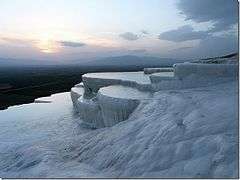Pamukkale
| Hierapolis-Pamukkale | |
|---|---|
| Name as inscribed on the World Heritage List | |
 | |
| Type | Mixed |
| Criteria | iii, iv, vii |
| Reference | 485 |
| UNESCO region | Europe, Turkey |
| Inscription history | |
| Inscription | 1988 (12th Session) |
Pamukkale, meaning "cotton castle" in Turkish, is a natural site in Denizli Province in southwestern Turkey. The city contains hot springs and travertines, terraces of carbonate minerals left by the flowing water. It is located in Turkey's Inner Aegean region, in the River Menderes valley, which has a temperate climate for most of the year.

The ancient Greco-Roman and Byzantine city of Hierapolis was built on top of the white "castle" which is in total about 2,700 metres (8,860 ft) long, 600 m (1,970 ft) wide and 160 m (525 ft) high. It can be seen from the hills on the opposite side of the valley in the town of Denizli, 20 km away.
Tourism is and has been a major industry. People have bathed in its pools for thousands of years. As recently as the mid-20th century, hotels were built over the ruins of Hierapolis, causing considerable damage. An approach road was built from the valley over the terraces, and motor bikes were allowed to go up and down the slopes. When the area was declared a World Heritage Site, the hotels were demolished and the road removed and replaced with artificial pools. Wearing shoes in the water is prohibited to protect the deposits.
Geology


Pamukkale's terraces are made of travertine, a sedimentary rock deposited by water from the hot springs.
In this area, there are 17 hot water springs in which the temperature ranges from 35 °C (95 °F) to 100 °C (212 °F). The water that emerges from the spring is transported 320 metres (1,050 ft) to the head of the travertine terraces and deposits calcium carbonate on a section 60 to 70 metres (200 to 230 ft) long covering an expanse of 24 metres (79 ft) to 30 metres (98 ft). When the water, supersaturated with calcium carbonate, reaches the surface, carbon dioxide de-gasses from it, and calcium carbonate is deposited. The depositing continues until the carbon dioxide in the water balances the carbon dioxide in the air. Calcium carbonate is deposited by the water as a soft jelly, but this eventually hardens into travertine.
Archeology
Museum
In this museum, alongside historical artifacts from Hierapolis, there are also artifacts from Laodiceia, Colossae, Tripolis, Attuda and other towns of the Lycos (Çürüksu) valley. In addition to these, the museum has a large section devoted to artifacts found at Beycesultan Hüyük that includes some of the most beautiful examples of Bronze Age craft.
Artifacts from the Caria, Pisidia and Lydia regions are also on display in this museum. The museum’s exhibition space consists of three closed areas of the Hierapolis Bath and the open areas in the eastern side which are known to have been used as the library and gymnasium. The artifacts in open exhibition space are mostly marble and stone. Hierapolis is broken down into ruins.
Tourist attraction
Pamukkale is a tourist attraction. It is recognized as a World Heritage Site together with Hierapolis. Hierapolis-Pamukkale was made a World Heritage Site in 1988.[1]
The underground volcanic activity which causes the hot springs also forced carbon dioxide into a cave, which was called the Plutonium, which here means "place of the god Pluto". This cave was used for religious purposes by priests of Cybele, who found ways to appear immune to the suffocating gas.
Tadpoles can be found in the pools.[2]
Protecting the thermal waters
The hotels built in the 1960s were demolished as they were draining the thermal waters into their swimming pools and caused damage to the terraces. Nowadays, water supply to the hotels are limited and they need to deposit the water used to the supply to generate.
Access to the terraces is not allowed and visitors are asked to follow the pathway. Due to the new regulations, visitors are only allowed to use small pools.[3]
Media
 The pools of Pamukkale
The pools of Pamukkale- Hot springs of Pamukkale
- The reflection of the limestone in a hot spring at Pamukkale
- The town of Pamukkale, at the foot of the hot springs
- A hanging limestone wall at Pamukkale
 Short video showing the Pamukkale natural site
Short video showing the Pamukkale natural site- Limestone wall
 The pools of Pamukkale
The pools of Pamukkale The pools of Pamukkale
The pools of Pamukkale
Sister cities
The village of Pamukkale has two sister cities:
Similar places
- Egerszalók in Hungary
- Badab-e Surt in Iran
- Mammoth Hot Springs in the USA
- Pink and White Terraces in New Zealand (destroyed in 1886 by volcano eruption)
- Hierve el Agua in Mexico
- The White Whale in Italy - Bagni San Filippo (Siena)
- Baishuitai in China
- Garmchashma in Tajikistan[4]
- Tatev in Armenia[5]
- Terme di Saturnia in Italy
Notes
- ↑ "Hierapolis-Pamukkale World Heritage Site". UNESCO World Heritage Centre. Retrieved 2007-06-23.
- ↑ "Pamukkale Turkey Hotel And Hostel Redesigned". PRLog. 2009-01-10. Retrieved 2009-09-02.
- ↑ Pamukkale Travetines Denizli
- ↑ Garmchashma in Tajikistan
- ↑ Satani Kamurj
External links
| Wikimedia Commons has media related to Pamukkale. |
- Pamukkale official site
-
 Pamukkale travel guide from Wikivoyage
Pamukkale travel guide from Wikivoyage - Pamukkale - spherical panorama 360 degree
- UNESCO World Heritage site datasheet
- The Marble Stairs of Heaven on Earth: Pamukkale
- Pamukkale Travel Guide
- Photos and first hand account of visit including Hierapolis and Cleopatra's pool
- Visiting the Cotton Castle – Geobeats.com on Youtube
Coordinates: 37°55.23′N 29°07.26′E / 37.92050°N 29.12100°E